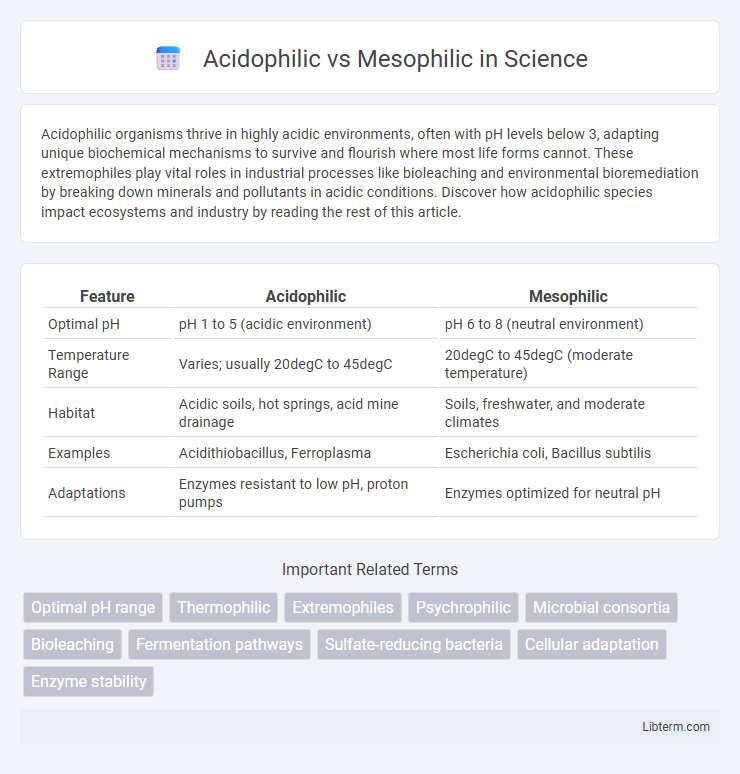Acidophilic organisms thrive in highly acidic environments, often with pH levels below 3, adapting unique biochemical mechanisms to survive and flourish where most life forms cannot. These extremophiles play vital roles in industrial processes like bioleaching and environmental bioremediation by breaking down minerals and pollutants in acidic conditions. Discover how acidophilic species impact ecosystems and industry by reading the rest of this article.
Table of Comparison
| Feature | Acidophilic | Mesophilic |
|---|---|---|
| Optimal pH | pH 1 to 5 (acidic environment) | pH 6 to 8 (neutral environment) |
| Temperature Range | Varies; usually 20degC to 45degC | 20degC to 45degC (moderate temperature) |
| Habitat | Acidic soils, hot springs, acid mine drainage | Soils, freshwater, and moderate climates |
| Examples | Acidithiobacillus, Ferroplasma | Escherichia coli, Bacillus subtilis |
| Adaptations | Enzymes resistant to low pH, proton pumps | Enzymes optimized for neutral pH |
Introduction to Acidophilic and Mesophilic Organisms
Acidophilic organisms thrive in highly acidic environments with pH levels often below 3, adapting specialized cellular mechanisms to maintain internal stability. Mesophilic organisms grow best in moderate temperature ranges, typically between 20degC and 45degC, and prefer neutral to slightly acidic pH conditions. These distinctions influence their ecological niches, metabolic pathways, and industrial applications such as bioleaching and fermentation.
Defining Acidophiles: Characteristics and Habitats
Acidophiles are microorganisms thriving in acidic environments with pH levels typically below 3, displaying specialized enzymes and cellular mechanisms adapted for acid tolerance. Common habitats include acidic hot springs, sulfuric pools, and acid mine drainages where they contribute to biogeochemical cycles. These organisms contrast with mesophiles, which prefer moderate pH ranges around neutral (pH 6-8) and inhabit environments such as soil, water, and the human body.
Mesophiles Explained: Features and Ecological Roles
Mesophiles thrive at moderate temperatures, typically between 20degC and 45degC, and play a crucial role in decomposing organic matter in soil and aquatic ecosystems. These microorganisms facilitate nutrient cycling, supporting plant growth and maintaining ecosystem stability by breaking down complex compounds into bioavailable forms. Their adaptability to diverse environments, including the human microbiome, underscores their ecological significance and potential applications in biotechnology.
Structural Adaptations in Acidophiles vs Mesophiles
Acidophilic organisms exhibit specialized structural adaptations such as highly impermeable cell membranes composed of tetraether lipids that minimize proton influx in extremely low pH environments. In contrast, mesophiles possess more fluid bilayer membranes suited for moderate conditions, relying less on extreme membrane rigidity. Acidophiles also maintain robust proton pumps and acid-stable enzymes that protect cellular components against acid denaturation, whereas mesophiles have standard enzyme systems optimized for neutral pH ranges.
Optimal Growth Conditions: pH and Temperature Tolerances
Acidophilic organisms thrive in highly acidic environments with optimal growth at pH levels ranging from 1.0 to 5.0, whereas mesophilic organisms prefer near-neutral pH levels between 6.0 and 7.5. Temperature tolerance for acidophiles typically spans from 25degC to 60degC, often favoring moderately warm conditions, while mesophiles grow best within a moderate temperature range of 20degC to 45degC. These distinct optimal growth conditions in pH and temperature reflect adaptations to specialized ecological niches and influence microbial applications in biotechnology and environmental processes.
Metabolic Pathways and Energy Production
Acidophilic organisms thrive in low pH environments by utilizing specialized metabolic pathways such as sulfur oxidation and iron oxidation, which enable efficient energy production under acidic conditions. Mesophilic organisms employ aerobic respiration and fermentation pathways that optimize energy yield at moderate temperatures and neutral pH, often relying on carbohydrate and lipid metabolism. The distinct enzyme adaptations in acidophiles support proton motive force generation in acidic milieus, while mesophiles maintain cellular homeostasis through balanced oxidative phosphorylation and substrate-level phosphorylation.
Industrial and Environmental Applications
Acidophilic microorganisms thrive in low pH environments, making them ideal for industrial bioleaching of metals and waste treatment in acidic conditions, while mesophilic microbes operate efficiently at moderate temperatures typical in wastewater treatment and composting. Acidophiles are crucial for biomining processes extracting copper and gold, whereas mesophiles dominate biogas production and organic matter decomposition in environmental biotechnology. The distinct temperature and pH preferences of these microbes optimize their roles in bioremediation, tailoring solutions to specific industrial and ecological settings.
Comparative Genomics and Evolutionary Insights
Comparative genomics of acidophilic and mesophilic microorganisms reveals distinct gene clusters linked to pH homeostasis and stress response, highlighting adaptive mechanisms in extreme environments. Evolutionary insights demonstrate horizontal gene transfer events and selective pressure driving functional diversification between these groups, underpinning their ecological specialization. Genomic analyses further identify conserved regulatory pathways that contribute to metabolic flexibility and survival across varying pH ranges.
Challenges in Cultivating Acidophiles and Mesophiles
Cultivating acidophilic microorganisms presents challenges due to their requirement for extremely low pH environments, often below pH 3, which can corrode standard lab equipment and inhibit contamination control. Mesophilic microbes thrive at moderate temperatures between 20-45degC, but maintaining optimal nutrient availability without promoting unwanted microbial competition is complex. Both acidophiles and mesophiles require precise monitoring of growth conditions, including pH stability and temperature, to ensure successful cultivation and reproducible experimental results.
Future Directions in Acidophile and Mesophile Research
Future research in acidophilic and mesophilic microorganisms emphasizes genetic engineering to enhance environmental resilience and industrial applications. Advances in metagenomics and proteomics are accelerating the discovery of novel metabolic pathways and biocatalysts for sustainable biotechnology. Integration of synthetic biology with adaptive evolution techniques aims to optimize acidophile and mesophile strains for bioremediation, bioenergy production, and pharmaceutical development.
Acidophilic Infographic

 libterm.com
libterm.com